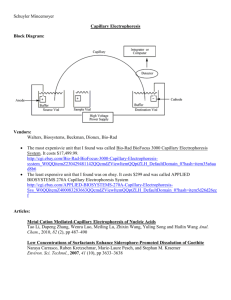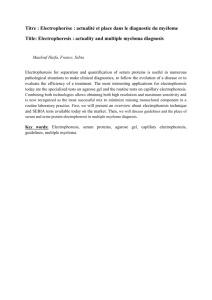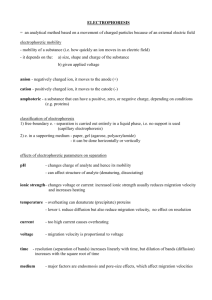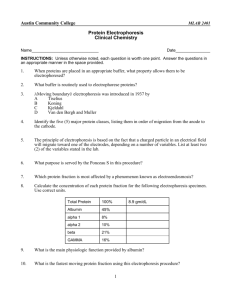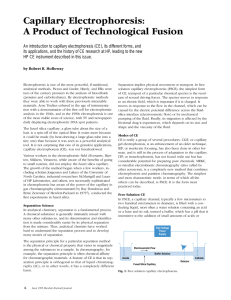Outline the principles of electrophoresis and review the advantages
advertisement
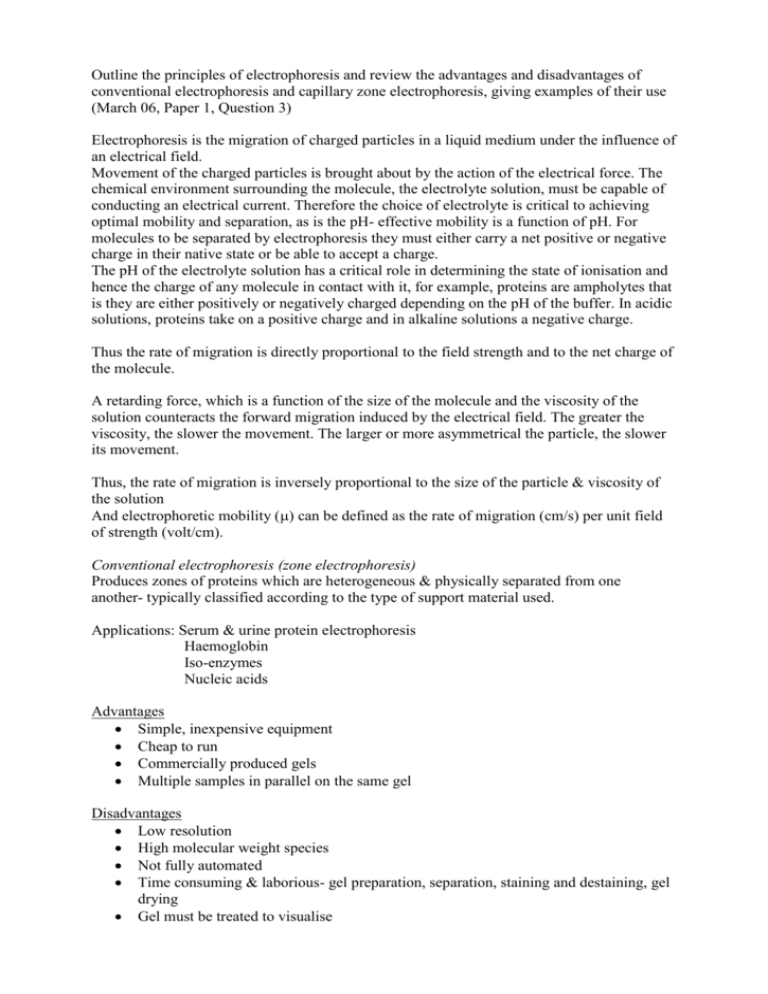
Outline the principles of electrophoresis and review the advantages and disadvantages of conventional electrophoresis and capillary zone electrophoresis, giving examples of their use (March 06, Paper 1, Question 3) Electrophoresis is the migration of charged particles in a liquid medium under the influence of an electrical field. Movement of the charged particles is brought about by the action of the electrical force. The chemical environment surrounding the molecule, the electrolyte solution, must be capable of conducting an electrical current. Therefore the choice of electrolyte is critical to achieving optimal mobility and separation, as is the pH- effective mobility is a function of pH. For molecules to be separated by electrophoresis they must either carry a net positive or negative charge in their native state or be able to accept a charge. The pH of the electrolyte solution has a critical role in determining the state of ionisation and hence the charge of any molecule in contact with it, for example, proteins are ampholytes that is they are either positively or negatively charged depending on the pH of the buffer. In acidic solutions, proteins take on a positive charge and in alkaline solutions a negative charge. Thus the rate of migration is directly proportional to the field strength and to the net charge of the molecule. A retarding force, which is a function of the size of the molecule and the viscosity of the solution counteracts the forward migration induced by the electrical field. The greater the viscosity, the slower the movement. The larger or more asymmetrical the particle, the slower its movement. Thus, the rate of migration is inversely proportional to the size of the particle & viscosity of the solution And electrophoretic mobility () can be defined as the rate of migration (cm/s) per unit field of strength (volt/cm). Conventional electrophoresis (zone electrophoresis) Produces zones of proteins which are heterogeneous & physically separated from one another- typically classified according to the type of support material used. Applications: Serum & urine protein electrophoresis Haemoglobin Iso-enzymes Nucleic acids Advantages Simple, inexpensive equipment Cheap to run Commercially produced gels Multiple samples in parallel on the same gel Disadvantages Low resolution High molecular weight species Not fully automated Time consuming & laborious- gel preparation, separation, staining and destaining, gel drying Gel must be treated to visualise Semi-quantitative- intensity of the stain may be poorly correlated with the amount of protein as uptake of the stain may occur in a non-linear fashion Capillary zone electrophoresis The classic technique of electrophoresis is carried out in a small bore (10-100µm) fused silica capillary column which is between 20-200cm in length. Applications: Serum & urine protein electrophoresis Haemoglobin Iso-enzymes Nucleic acids Advantages The main advantage comes from efficient heat dissipation compared to traditional electrophoresis- due to large internal surface area to volume. This enables the use of high field strengths which deceases analysis time and minimises band diffusion. Separation in free solution without requirement of a casting gel Detection occurs as the separation progresses with resolved zones producing an electronic signal as they migrate past a UV absorbance or fluorescence detector for example. This configuration increases efficiency. No staining or destaining Quantitative information- results displayed as an electropherogram & integrated in form of peak area or height Automated Separation of low molecular weight ions, proteins & other macromolecules Small sample volume- minimises the distortion in the applied field caused by the presence of sample Disadvantages Single sample injected- limited throughput, multiple samples are analysed serially Larger sample volumes required for autosampler - dead volume Inner diameter of the capillary tube is also the pathlength of the cuvette- limited detection limit- lower sensitivity



